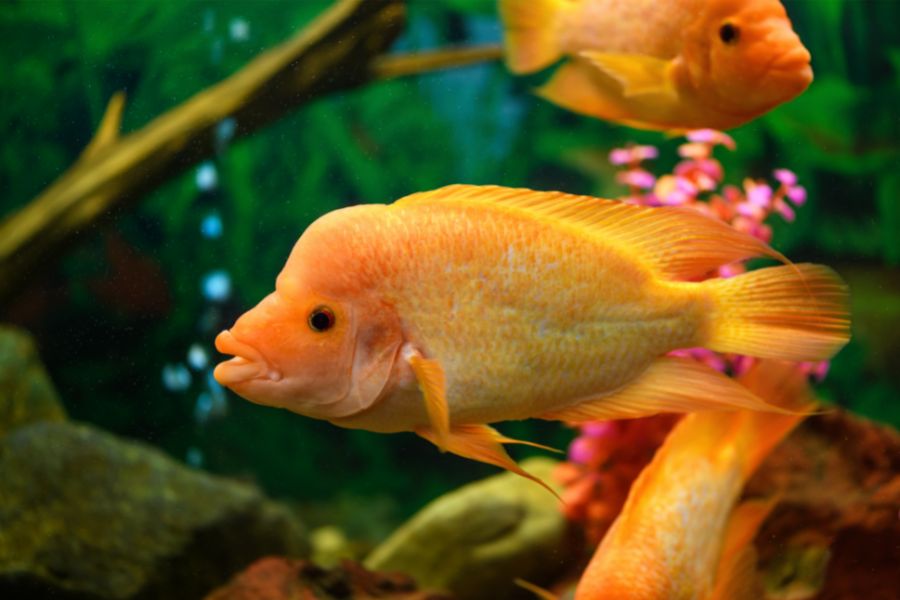The red devil cichlid(Amphilophus labiatus) is a surprising species that will bond with you like no other but shock you with how aggressive it is to its tank mates.
Aquarists love them for their lovable, charismatic temperament but avoid them for their aggressive temperament.
Red devil cichlids are ranked as one of the world’s most aggressive freshwater fish, with the red-bellied piranhas. Because of this, expert aquarists have learned to keep them in their species-only tanks.
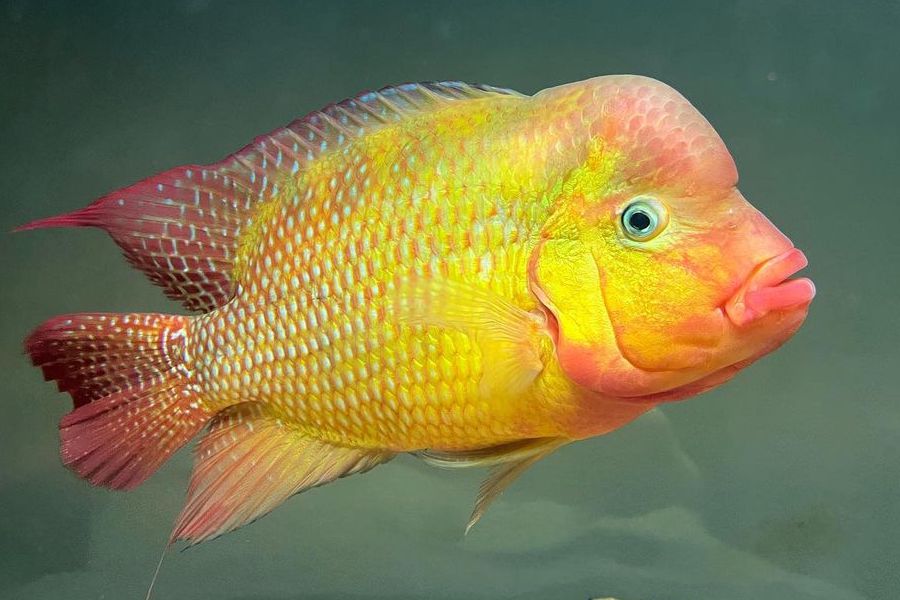
Did you know: The red devil cichlid is a name used to refer to two different types of fish?
Amphilophus labiatus is the scientific name of the real red devil cichlid, but the Amphilophus citrinellus, sold as Midas cichlid, is also called by the same name by the hobbyist community.
This article will dive into what makes the Amphilophus labiatus unique and how to care for this red devil cichlid.
Red Devil Cichlids Overview
Short Summary on Red Devil Cichlids and their habitats:
| Names | Red Devil Cichlids (Amphilophus labiatus) |
| Origins and Reginal Distribution | Originated from Central America in Lake Nicaragua, Xiloa, and Lake Managua |
| Tank Size | 55 gallons Minimum for a single red devil
125 gallons minimum for breeding pairs 200 gallon minimum for a community |
| Water Hardness Conditions | 6 – 25 dGH |
| Average Size | 15 inches |
| Colors | Polymorphic with a wide range of colors, including red, pink, orange, yellow |
| Lifespan | Typically, 10 years, but can live up to 12 years in the ideal environment |
| Diet | Omnivorous |
| Optimal pH levels | 6.5 – 7.5 |
| Optimal Temperature | 75 – 80 degrees Fahrenheit |
Red Devil cichlids, as their name suggests, have a lot in store for any hobbyist looking forward to owning one for the first time.
They are an intimidating bunch that will draw you near with their personality and perceptiveness. Their huge size of more than ten inches will put you to work since you will need a bigger tank and do more maintenance work.
However, if you have already set your mind on the attractive fish, you should know a few things, from its long lifespan to its unique behaviors.
Firstly, do not confuse the Midas cichlid (Amphilophus citrinellus) with the real red devil (Amphilophus labiatus).
Check out this video to see what a true red devil cichlid looks like:
And this other video for a true Midas cichlid.
Here are a few key differences between the two:
- The Amphilophus labiatus has bigger lips than the Amphilophus citrinellus(Midas cichlid). In fact, labiatus means ‘lips’. Red devil cichlids have larger pointier lips as well as longer snouts.
- Also, a male Midas cichlid (12 inches average max size) is generally bigger by about two inches when compared to a male red devil cichlid.
- Midas cichlid is spread across many regions from Central America to Costa Rica, while labiatus is only found in Lake Nicaragua and Lake Managua.
Lifespan
The lifespan of the red devil is 12 years in an ideal environment.
This is a longer lifespan than other cichlid species like the African cichlids, which tend to die at around the five-year mark.
Appearance: Size, Colors & Features
It is among the biggest aquarium fish. Red devil cichlid’s max size is about 15 inches, and the fish’s growth rate is so fast that you can expect it to reach its full size in about three years.
The red devil cichlid’s teeth are sharp and powerful; they can bite into anything in the tank, and if they don’t, then the force with which the powerful jaw shuts may cause physical damage to the tooth.
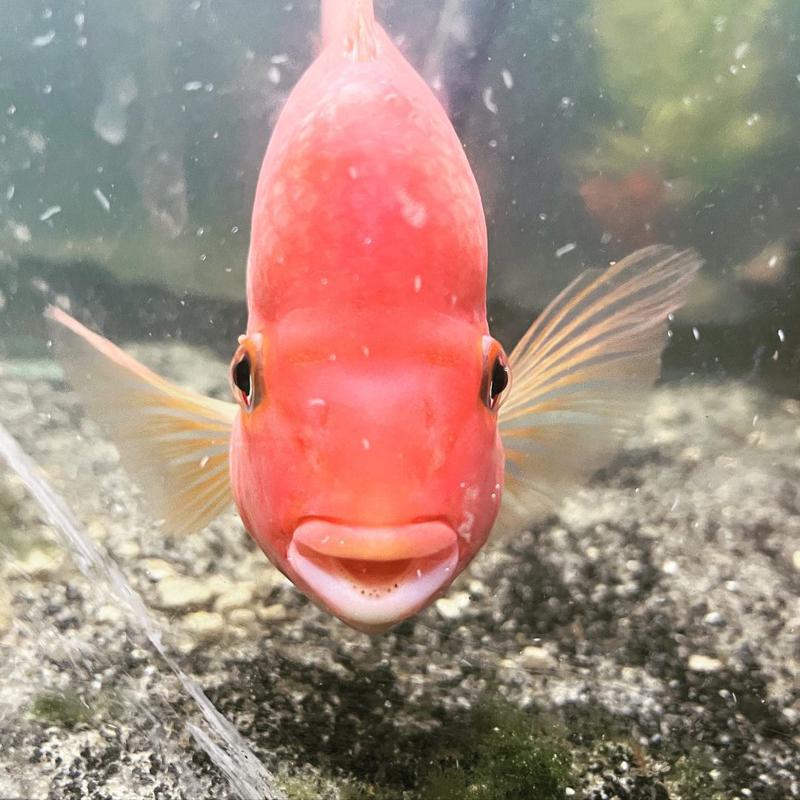
These cichlids do not come in one distinct color. Midas cichlids are often born dull grey and eventually shift their color to various arrays like yellow, red, or orange.
On the other hand, red devil cichlids are born with various shades, from white to green to red to pink to yellow to orange.
Some may feature a few spits and stripes here and there, but it is very common to see a red devil one complete color.
Their bodies are thick and feature pointed anal and dorsal fins that flow uniformly backward.
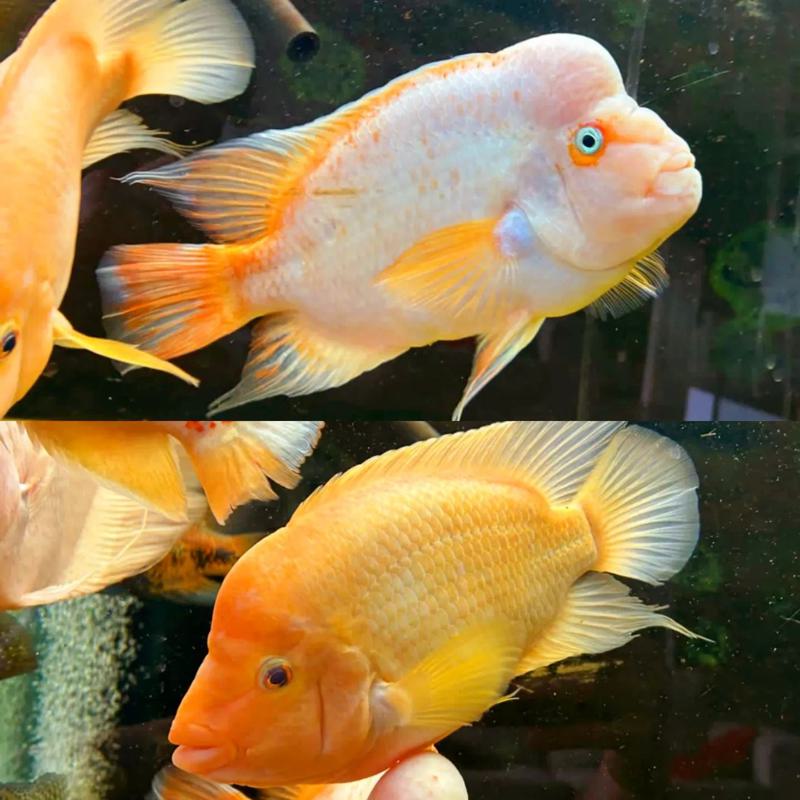
A unique feature of the species is the nuchal humps on top of their foreheads. These are present in both the male red devil cichlid and the female; however, they are bigger and more noticeable in males.
It is important to note that the nuchal hump shows up during the breeding season and sometimes gets permanent when in an aquarium habitat but typically disappears in the wild environment after breeding.
Trying to figure out a red devil cichlid male vs. female before the breeding season is only possible because of the genital papilla. Males have a pointed genital papilla, while females have a flat papilla.
Behaviors
Red devils are named as such for their aggression and extremely territorial behavior. These fishes have been known to bite strangers and destroy beautiful décor in the aquarium.
They are active swimmers and diggers who won’t waste time roaming the tank as fast and roughly as they can.
They put many things into their mouth so long as they can eat them, crush them, or toy with them. They are territorial fish that dominate their environment by digging into the substrate, destroying décor and plants, and hitting rocks.
Which is why it shocks a lot to find out how attached they are to their owners. The compassion and affection they have towards their caretakers is comparable to how a dog behaves when the owner comes back home. It is a sight to see.
Red devils become less aggressive when they are not in a stressful environment. Creating an aquarium with a huge tank and an ideal tank environment helps keep them at bay.
Red Devil Cichlid Care
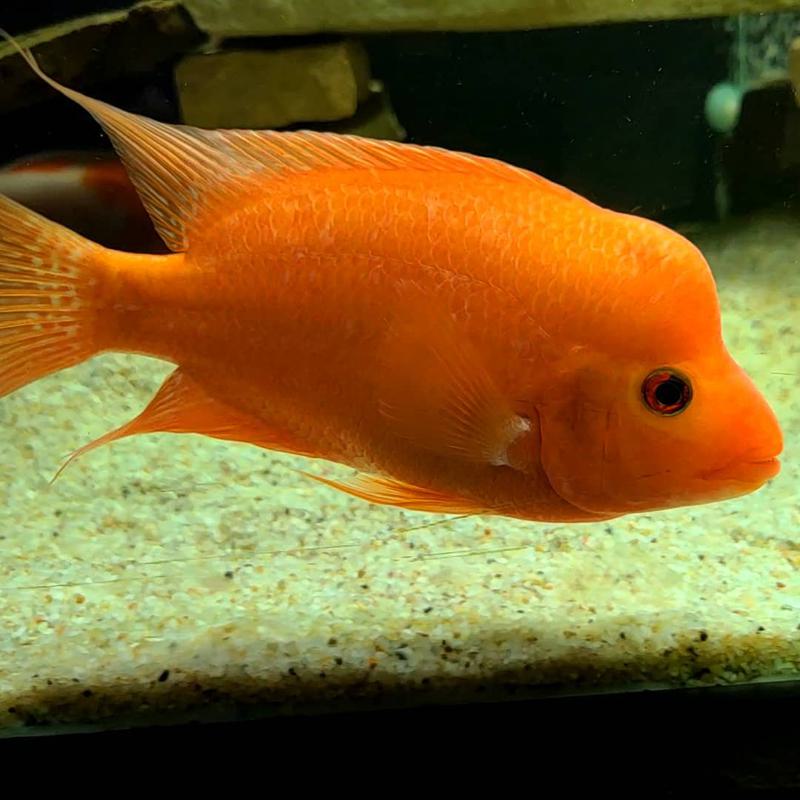
You won’t need much to have a thriving community of red devil cichlids, only if you are not a beginner.
This is not an amateur-level hobbyist fish to own. Red devils are for experienced aquarists who have enough expertise in caring for aggressive large fish.
Tank Size & Environment
The tank size is the most important aspect since red devils swim constantly. They like to explore the tank, and the bigger the space, the better. One red devil cichlid per 55 gallons is the minimum tank size.
In case you want to breed using one pair of red devils, then a tank of about 125 gallons will get the job. However, anything more than that will require you to get a tank that can carry at least 200 gallons to provide the much-needed huge swimming space.
It is vital to protect sensitive parts and equipment in the aquarium because such an aggressive fish will sooner or later damage any exposed systems.
Place the devices outside or hide them well. You should also consider insulation and putting strong barriers that can’t be easily yanked out.
Red devil cichlids are strong and rough in their aggression. This means your precious plants with weak roots will not survive.
They also have a habit of eating plants. You may try different plants to see which ones are harder to uproot, but it is a good practice to get rid of the plants all together.
Use fine sand as the substrate since red devils are fond of digging and rustling about in smooth matter. Anything rocky and hard will hinder their movement and make it easier for them to get physical trauma or injury-related infections.
Also, the red devils will toss any unanchored rocks as they move, which may damage your aquarium.
Décor, with touches of wood and rock, provides a great hiding spot for red devils.
They may not need it for hiding purposes as they would in the wild, but it helps simulate their natural environment, which is healthy for them, especially if you want them to behave as they would in their natural habitats.
The Best Red Devil Cichlid Tank Mates
The best way to raise a red devil is to keep one of the fish in an individual tank. Their territorial aggression does not make them the best tank mates to other species and not even to their own kind.
The best idea when considering a community is to pair the fishes when they are younger. This helps in creating a harmonious atmosphere from an early age, but it doesn’t last long since their aggression comes out when they mature.
Pick a huge tank above 200 gallons if you want to include other red devils or another aggressive species that can co-exist with them; the larger, the better.
The best red devil cichlid tank mates include other red devils, and other cichlids like the firemouth cichlid, jaguar, convict cichlids, red zebra cichlids, and Jack Dempsey.
What about Oscar, can Oscar and Red Devil live together?
These two fishes are huge (above 14 inches), and keeping them together will not only require a massive tank, but you will also have two very aggressive creatures to care for.
As a rule of thumb, it is best to keep them separate to reduce the stress and give them their own space.
Water Quality & Water Parameters
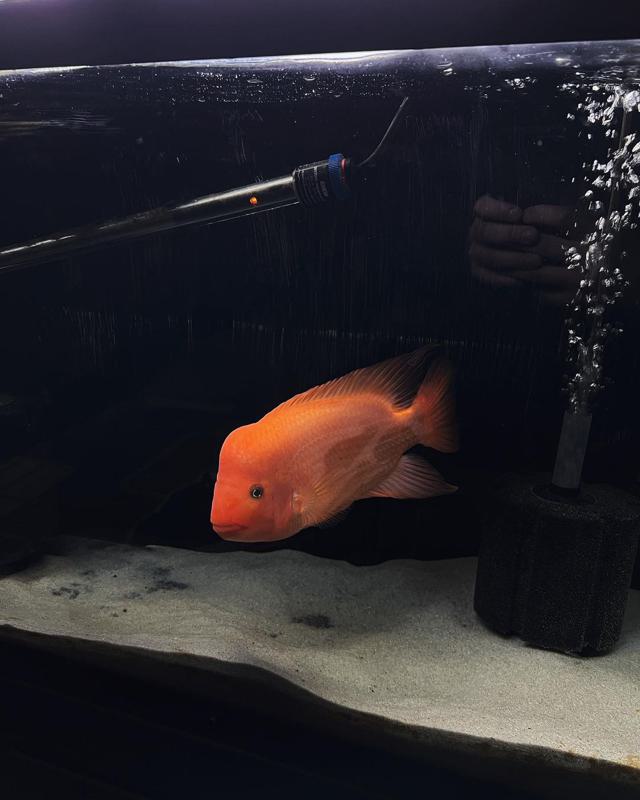
Most diseases that will destroy your fish will come from poor water quality and bad water parameters. The red devil cichlid is hardy and can survive a few changes and instability, but this won’t go on for long.
The best parameters include the following:
- Water Temperature: 75 – 80 degrees Fahrenheit
- pH level: 5 – 8.4
- Water hardness: semi-hard between 18 – 20 DH
- Ammonia, nitrite levels: 0 PPM
Also, red devil cichlids prefer well-oxygenated water. You can add more oxygen to the system by using air-stone equipment.
Due to their hardiness, the fish can survive in a wide range of lighting conditions, from normal to dim to moderate and high.
The red devil’s size, constant eating habits, and active movement make them a messier species than most. Regular weekly routine maintenance and constant water test are important to prevent common illnesses from attacking the fish.
A good practice is to perform 25% – 35% weekly water changes to prevent the dangerous ‘hole-in-the-head disease’ caused by the accumulation of biowaste, phosphates, water hardness, and nitrates.
Red Devil Cichlid Diet
The species lives on an omnivorous diet. The red devil cichlids are active eaters that you should feed many times during the day, unlike smaller fish that you would often feed at most three times. Cichlid and fish flakes are among their favorite snacks.
Red devils also feed on tank animals, from smaller fish to the invertebrates like snails and nymphs. Please remember that they are more likely to eat some of their tank mates when they are starved or stressed.
Other recommended meals in their diet include:
- Krill
- Crickets
- Vegetables like peas, spinach, cucumber, broccoli, lettuce, and zucchini
- Frozen foods from bloodworms to krill
- Brie shrimp
- Earthworms
Breeding
Red devil cichlids reproduce by oviparous, where the female lays eggs that aren’t fertilized, and the male fertilizes eggs after they are out in the open water.
The cichlids are also maternal breeders and will care for their young ones until they are able to swim freely and live on their own.
The male and female are ready to breed when they reach 6 -7 inches, about three years after their birth.
It is important to keep an eye on their size when purchasing because they can start populating your tank without much warning (a female red devil cichlid lays 600 to 1000 eggs in one breeding season).
Higher temperatures than the normal ideal are important for the breeding process. Typically, a temperature below 78 would be great but above 78 degrees Fahrenheit is better for breeding since this is the natural breeding season temperatures in the wild.
You also need to have a tank where there are flat substrates like wood and rock where the female can lay its yellow/orange-looking eggs.
Steps to take for breeding red devil cichlids in an aquarium:
- Place the breeding pair (one female and one male) in a separate tank with lots of nutritious foods they can eat as they move about.
- Raise the temperatures above 77 degrees, ideal 78-80 degrees Fahrenheit.
- The female red devil will lay about 700 eggs on the surface and will hatch after four days max.
- Observe as the male and female maternally take care of the fry hatch till it reaches about seven days old. Both parents are both extremely territorial at this stage. Males and females contribute to taking care of the fry by hiding it in the sand substrate and other hiding places.
- This goes on for about one week, and then the fry will be old enough to swim freely and hold its own.
- The fry will then be set free to roam around. Even though the fish is hardy, the diet is more important here; try highly nutritious foods like bloodworms and artemia nauplii. They will be able to eat regular fish food at this time.
Best parameters for red zebra cichlids to breed:
- Temperature: above 78 degrees Fahrenheit
- Diet: High Vegetable Diet, fewer proteins/meats diet (good foods include fry fish and fry groundfish flakes)
- Water pH levels: Above 6.7
- Water Hardness: 6 – 25 dGH
Also Read:
Summing Up
Illnesses like ich are common with the red devil cichlids. The good news is that there are no dangerous infections that specifically affect them, which makes it easier to diagnose and prevent such illnesses.
You can prevent the ich and other common illnesses like hole-in-the-head disease by maintaining the right temperature and performing at least 25% weekly water changes.
